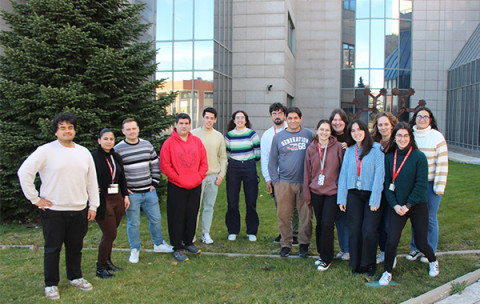The 2024 Frontiers in Materials Science courses conclude with more than 70 students

The two courses Frontiers in Materials Science for 2024 have already been completed at the Materials Science Institute of Madrid (ICMM-CSIC). This year, nearly a hundred students applied for one of the 40 available slots, and ultimately 40 individuals attended the first course (Design and Preparation), while the second (Tailored Properties for New Technologies) was followed by 32 students.
These are two free courses within the Postgraduate program of the Spanish National Research Council (CSIC) that introduce students to research at the forefront of materials science. Each course, which has a hybrid format and is attended remotely by students, mainly from Latin American countries such as Mexico, Brazil, Ecuador, Panama, and Colombia, lasts for one week. Specifically, online students have 32 hours of theory classes, while those attending in person also enjoy eight hours of laboratory practice at the ICMM.
"The courses aim to provide a broad overview of the topics at the forefront of materials science," explains Jesús Ricote, a researcher at the ICMM-CSIC and director of this postgraduate program. Each course is structured as a series of classes taught by center staff who are experts in the field. Thus, each class addresses, after a brief introduction presenting the basic fundamentals necessary to understand the research approach, its current development, and possible lines of advancement.
For the first course, 'Design and Preparation,' the material focuses mainly on aspects related to the development of materials with specific properties, with applications in energy, health, and electronics. On the other hand, in the second course, 'Tailored Properties for New Technologies,' the focus shifts to the utilization of the physical characteristics of different materials (optical, electrical, magnetic, superconducting, topological) and their surfaces. In this case, the goal is to tackle new challenges: "for example, in nanoelectronics or quantum computing, with a specific mention of the use of simulation and artificial intelligence in this context," details Ricote.
In this way, a journey is made through various types of materials currently of interest due to their fundamental properties and/or applications; both the preparation and characterization procedures of the materials are described, as well as the models to explain the underlying physical phenomena in the properties under study, in addition to the design of applications and devices based on them. Finally, open problems are usually considered, outlining the current limitations to solve them.
The topics covered include very diverse areas: molecular and supramolecular materials, biomaterials, materials for health, coatings, nanophotonics, spintronics, multiferroic materials, materials for energy conversion and storage, graphene, superconductors, and quantum computing, among others.
Instituto de Ciencia de Materiales de Madrid (ICMM)
Sor Juana Ines de la Cruz, 3
Cantoblanco, 28049
Madrid, España
Telephone: (+34) 91 334 90 00
Email: @email
Communication Office: @email

Acknowledge the Severo Ochoa Centres of Excellence program through Grant CEX2024-001445-S/ financiado por MICIU/AEI / 10.13039/501100011033

Contacto | Accesibilidad | Aviso legal | Política de Cookies | Protección de datos